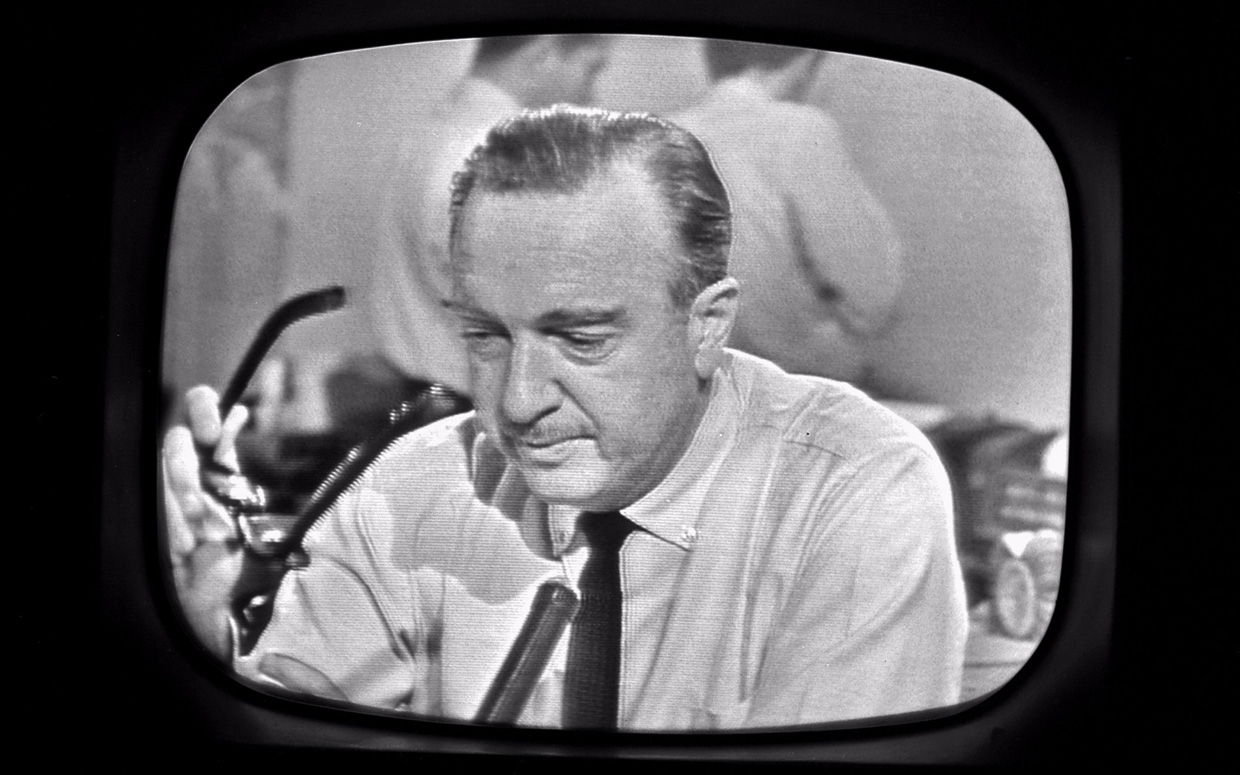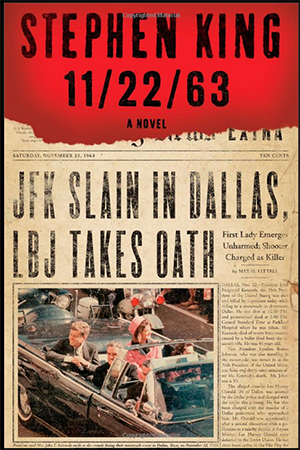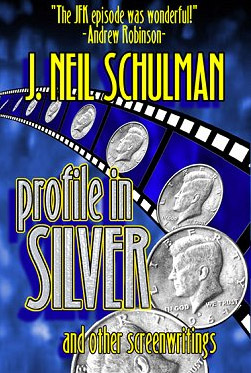|
|||||||||||||||||
November 2009 Web Edition Issue #3 |
|||||||||||||||||
| Mondo Cult Forum Blog News Mondo Girl Letters Photo Galleries Archives Back Issues Books Contact Us Features Film Index Interviews Legal Links Music Staff |
The Ides of Marchby Brad LinaweaverThat time of year is on us again, when assassins emerge from the shadows, knives glinting in the cruel light. We remember the assassination of Julius Caesar. I once wrote an alternate history about Caesar for Harry Turtledove's Alternate Generals. In my story, Caesar changes his politics at the penultimate moment. Then he's murdered by Mark Antony. Just goes to show that when your time is up, your time is up. Originally, Jessie and I were going to devote this space to an update article on Silicon Assassin. After all, there's a lot of assassinatin' going on in that epic. I'm halfway through the article, "Are We Free Yet?" What has put the article on hold is a timely piece by our own J. Kent Hastings that needs to be highlighted now. Long after the assassination of Caesar, two American Presidents had epochal historical deaths: Abraham Lincoln and John F. Kennedy. In common with Caesar, these deaths inspired many artistic explorations of great leaders cut down. Kent has a true story to tell about a science fiction tale regarding JFK on that fateful day in Dallas, and how it relates to one of our writers for Mondo Cult. Before Jessie introduces one of the most important articles ever to appear in MC, in my humble opinion, let me say a few words about the upcoming article on Silicon Assassin. Our three primary directors have a lot going on. Richard Hatch, the series star, directed "Problem Child," the first episode. The painting you see here is by L. J. Dopp and portrays the original SA team. Left to right are: Vicki Marie Taylor, Paula LaBaredas, the painting inside the painting of Chuck Hammill, his father Charles P. Hammill, Victoria Plumb and Richard Hatch. They are holding rayguns designed by Dopp. Christopher Douglas-Olen Ray not only directed the most episodes, but his "Window of Opportunity" won an international award that reflected on the whole series. Edward L. Plumb won an amazing number of awards for his "Dead Reckoning." Not only was it honored with a showing at the Chinese Theatre Hollywood, but has eclipsed 100,000 YouTube views. As for our wonderful cast throughout the series, I count myself the luckiest bastard in Hollyweird to have found so much talent for this truly idiosyncratic project. Then there's everyone else, from music to the technicians. I owe abundant thanks to many, including Jessie for managing the YouTube page. Watch this space. Where Were You?by Jessie Lilley“Where were you when they shot JFK?” That was the question. It was asked time and again throughout the 60s and 70s and even sometimes into the 80s if you were “older”. I was at the kitchen table eating a baloney sandwich with my mother’s friend June McManus (née Stefan). My mother was in the living room and had tuned the TV to some cartoon that I liked. I would be going in there to watch while Mama and June did whatever grownups do. I remember I heard my mother scream. Actually, really scream. June dropped her glass of milk and ran into the living room shouting at me to stay where I was. She ran head on into my mother who was running back into the kitchen. She said, “My God June, they shot Jack!” Then they both burst into tears. (Below is the iconic shot of legendary Walter Cronkite announcing to the nation that the President had been shot.)  Yes, I really do remember it that clearly. I was only 5 years old and that was a fairly momentous chain of events in my kitchen. Within half an hour my brother was home from school. The schools had been closed. Daddy was home from work an hour later. It was as if life stopped. Everything was very quiet at home and in the neighborhood. Everyone was safe inside and glued to their TV sets. And life went on. I grew into a huge horror and science fiction fan and found myself reading Hunter S. Thompson to feed my political desires and eventually Stephen King for my horror fixes. I discovered Libertarianism, the ability to write stuff myself and eventually found myself in the editor’s chair of various magazines devoted to my particular joys. I’ve met many writers over the years and am always pleased to find their names plastered all over my publications as well as newsstands, bookshelves, television and film credits, ad nauseam. I like to see my “band of literary outlaws” getting the credit they so richly deserve and am always flattered if one or the other tips a hat in my direction for whatever reason. I really have nothing to do with what they produce. I just make it look pretty and make sure they haven’t inadvertently come too close to someone else’s work. Imitation may be considered the highest form of flattery, but everyone needs a strong editor. Wouldn’t you agree? 
The Lone Writer Theoryby J. Kent HastingsI listened to the unabridged audiobook edition of Stephen King's novel 11.22.63, after being favorably impressed by the first episode of Hulu's eight-part miniseries. The story is of a time-traveling teacher from 2011 interacting with the JFK assassination. The miniseries starts from 2016. Both effectively portray the shocking differences between the 21st Century and circa 1960, including music, dancing and food of the time as well as the inevitable social commentary about colored restrooms and sexism. The miniseries has a strong cast led by James Franco and Sarah Gadon. Neither work has a villain from New England with the initials R.F., but the novel has other King touches, such as little poor kids playing around Lee Harvey Oswald's slummy apartment, a recently disappearing kid-killing clown in a small town and the time-traveling English teacher protagonist preemptively shooting a man placing flowers at his parents’ grave site who would otherwise murder his own children and wife with a sledgehammer on Halloween in 1960, except for the surviving son he only hit on the head. The resulting brain injury leaves the boy to become an addled old janitor taunted by school kids decades later, a sincere “Lennie” character (a King staple–a school play of Of Mice And Men is even featured in the novel). The janitor reading his adult education assignment about the original bloody incident inspires the teacher to intervene as a test of the time bubble (found by a diner owner played by Chris Cooper) in an early go round with “the obdurate past.” Several cycles back and forth through time are compressed into one attempt to change history in the miniseries. Some characters and events are different from the novel. Stephen King is certainly not the Lone Writer working characters central to the Kennedy assassination into fiction. The earliest writer to take a shot at it from the Grassy Knoll, appeared in a Samuel Edward Konkin III publication as well as other libertarian and anarchist counter-cultural publications, and Discordian works associated with the likes of Robert Anton Wilson. I’m referring, of course, to Kerry Wendell Thornley’s 1962 manuscript of The Idle Warriors. Here’s what Wikipedia has to say about Mr. Thornley: “In February 1962, Thornley completed The Idle Warriors, which has the historical distinction of being the only book written about Lee Harvey Oswald before Kennedy's assassination in 1963. Due to the serendipitous nature of Thornley's choice of literary subject matter, he was called to testify before the Warren Commission in Washington, D.C. on May 18, 1964. The Commission subpoenaed a copy of the manuscript and stored it in the National Archives, and the book remained unpublished until 1991. In 1965, Thornley published another book titled Oswald, generally defending the "Oswald-as-lone-assassin" conclusion of the Warren Commission, which met with dismal sales. In his later years, Thornley became convinced that Oswald had in truth been a CIA asset whose purpose was to ferret out suspected Communist sympathizers serving in the Corps.” This year, the Dallas Morning News reviewed the miniseries 11.22.63, much of it set in their backyard, and mentioned another libertarian anarchist writer published by Samuel Edward Konkin III (along with Robert Anton Wilson)–J. Neil Schulman, a writer who also has articles appearing in the pages of Mondo Cult magazine. The complete Dallas Morning News review may be found HERE, and here is an excerpt from it: “It's been said that 11.22.63, both the Stephen King best-seller and its eight-hour made-for-Hulu counterpart premiering Monday, play like the longest episode of The Twilight Zone ever made. Only because, well, that's just what it is.” “Thirty years ago come March, CBS, which briefly revived Rod Serling's most famous creation, aired the J. Neil Schulman-penned episode "Profile in Silver," in which a history professor time-travels 200 years into the past and eventually lands in Dealey Plaza on Nov. 22, 1963, where he stops the killing of John F. Kennedy–only to discover his actions could lead to the end of the planet. Which is more or less the same plot of 11.22.63 ....” “Profile In Silver” also had a strong cast, with Lane Smith as Professor Fitzgerald, the “field historian” and Andrew Robinson as JFK. The effects were good for 1986 television.  Andrew Robinson as JFK in J. Neil Schulman's "Profile In Silver". Both stories feature killer tornadoes as an immediate response by “a past that doesn’t want to be fucked with.” Coincidence or Conspiracy? Another early entrant with the Kennedy assassination in science fiction is the novel A Time To Remember by Stanley Shapiro, published four months after “Profile In Silver” aired on CBS, and the basis for the 1990 movie Running Against Time.
“History professor David Rhodes never has got over the death of his older brother, 1966 in Vietnam. When he hears the rumor that a famous professor is working on a time machine, he immediately contacts him and persuades him to allow him to travel back in time and correct history. If he could save President Kennedy's life, Vietnam war might never have happened!” A plot summary on IMDB, written by Tom Zoerner. 
From J. Neil Schulman’s Profile In Silver and Other Screenwritings, a book with Neil’s scripts and accounts of how they were produced (and changed) or sometimes not produced at all, comes this history of JFK in fiction: “Profile in Silver was controversial, inasmuch as nobody at that time had ever used the JFK assassination as a plot element in a TV show, or portrayed President Kennedy and his family in a fictional context. All previous portrayals of John F. Kennedy had stayed extremely close to real life, from PT-109 to The Missiles of October.” “How things have changed now! Oliver Stone’s JFK portrayed the assassination from the point of view of New Orleans District Attorney Jim Garrison, who believed in a conspiracy. Quantum Leap put us inside the body of Lee Harvey Oswald and the series lead character, Sam Beckett, changes history by preventing Jackie Kennedy from being assassinated also. The X-Files has the Cigarette Smoking Man assassinating JFK from an underground sewer and setting up Oswald as a patsy. And NBC’s new series Dark Skies has JFK assassinated because he’s been told the truth behind the UFO landing at Roswell. I sometimes wonder whether any of these projects could have made it past industry executives if “Profile in Silver” hadn’t been on CBS prime-time first.” How likely is it that Stephen King saw “Profile In Silver”? The reach of the show according to Schulman: “The hour containing “Profile in Silver” was the only one which they ran three times in prime time, before the show went into syndication, where it has run another dozen or so times in a half-hour edition … the power of television is such that even a single episode of a series show that never got more than mediocre ratings after the first week or so has been seen by so many millions of people that it’s probably the only thing of mine that most people have ever seen.” What did King see and when did he see it? The Truth Is Out… (sorry, that’s copyrighted). If “The Dealey Lama” (Thornley) wasn’t certain, then it’s anyone’s guess. |
||||||||||||||||





